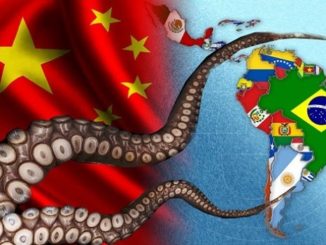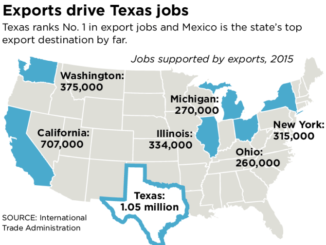by Mitchell Schnurman, Dallas Morning news
Donald Trump promises to build a bigger, badder border fence in Texas?
Sorry, pardner. We don’t want it.
No state benefits more from having Mexico as a neighbor — historically, culturally and economically. Instead of more barriers, leaders should be talking about making it easier to move goods and people across the border. They should be trying to free up public money for roads and infrastructure.
Thanks to Mexico, Texas has become the top exporting state by far. It topped No. 2 California by over $100 billion last year. And trade with Mexico has been growing strongly despite a buildup in border security and drop in Mexican immigration.
Last year, the value of Texas exports to Mexico hit nearly $103 billion. That’s almost twice as high as five years earlier, and Texas now exports more merchandise to Mexico than to the next 10 countries combined.
The gaudy export totals are just half the story. Texas imports a lot from Mexico, too — over $90 billion in merchandise in 2014. And here’s the kicker: 40 percent of the content in those Mexican imports was made in the USA.
By comparison, the U.S. provides just 4 percent of content in Chinese imports.
That extra content means more jobs and commerce for Americans. Just as important, it reflects the growing integration of the two economies.
“We’re more partners than competitors,” said Christopher Wilson, deputy director of the Mexico Institute at the Woodrow Wilson International Center for Scholars.
In autos, electronics, appliances and heavy machinery, companies on both sides of the border often share production, connected by regional supply chains. That’s among the benefits of the North American Free Trade Agreement adopted by the U.S., Canada and Mexico about 20 years ago.
Cars built in North America, Wilson said, may cross U.S. borders eight times during production as manufacturers integrate materials and parts developed in Mexico and Canada.
“This spreads fixed costs and increases productivity and competitiveness,” said Jesus Cañas, a business economist at the Federal Reserve Bank of Dallas.
Export juggernaut
Since the recession, Texas has grown exports much faster than the nation. And in manufacturing exports, it’s gained market share against California, Illinois and Ohio, according to his research.
Cañas’ hypothesis: “Texas is capitalizing on these relationships with Mexico,” he said.
Trade with Mexico creates an estimated 6 million jobs nationwide and almost half a million jobs in Texas. And foreign labor, led by Mexicans, has played an even larger role in Texas’ economic success.
From 1990 to 2010, over 40 percent of the growth in the Texas workforce came from foreign-born workers migrating to Texas, according to a 2013 report by Dallas Fed economist Pia Orrenius and others.
That’s beefed up the supply of occupations at both ends of the skills spectrum. While immigrants accounted for 16 percent of Texas’ college-educated workers, they had twice that share of jobs for medical scientists, software developers and doctors. Immigrants also accounted for an outsize share of groundskeepers, construction laborers and housemaids.
This larger, more varied workforce allows for more specialization. Highly educated natives have a comparative advantage in interactive and communications jobs, the report said, while highly educated immigrants excel in quantitative and analytical jobs. This Texas blend increases efficiency, boosts labor productivity and raises output.
“Immigrants help power and grease the economy’s engines,” Orrenius, et al. wrote in the report, “Gone to Texas: Immigration and the Transformation of the Texas Economy.”
Far-reaching effects
Prices for some goods and services decline because of foreign-born workers. For Texas natives, the so-called immigration surplus is worth $3.4 billion to $6.8 billion a year, the report said, and effects can be far-reaching.
Research shows that immigration lowered child-care costs and “significantly increased the labor supply of highly educated native women,” the report said.
Have Texans lost jobs or had wages depressed by the influx of immigrants? “It doesn’t appear so,” the report said.
There are net costs with some immigrants, primarily to state and local governments. But Texas has a skimpy safety net and state revenue depends largely on sales and property taxes, which everyone pays. Even unauthorized immigrants boosted state revenue by more than their costs for education, health and other expenses, according to a 2006 comptroller’s report.
Texas also is considered immigrant-friendly, even with the frequent focus on border security. It was the first to offer in-state tuition to the children of all immigrants. Some lawmakers tried to repeal the law last session but it survived.
In the same way, business keeps growing between Texas and Mexico even when the politics turn ugly. But the anti-immigrant talk makes it tough for real reform, and that could lift the economies more.
“That rhetoric matters, and it’s absolutely holding us back right now,” Wilson said.
So when Trump makes a campaign stop in Dallas Monday, how do we get him to change the subject?




